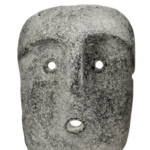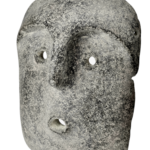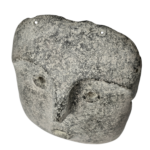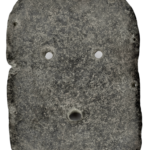Condorhuasi-Alamito Stone Mask
Intricate Details and Artistic Narrative of this
Condorhuasi-Alamito Mask
The Condorhuasi culture, flourishing in pre-Columbian Argentina during the Late Archaic period (circa 400 BC to 500 AD), was centered in the Calchaquí Valleys, spanning provinces like Salta, Tucumán, and Catamarca. Characterized by distinctive circular structures and semi-subterranean buildings with central support posts, Condorhuasi sites showcase advanced architectural features. Their ceramics, adorned with geometric designs and stone sculptures, provide valuable insights into their craftsmanship. Engaging in agriculture at high altitudes, the Condorhuasi people cultivated maize, beans, and squash. Burial practices included collective sites with accompanying grave goods, shedding light on their cultural rituals. Participating in regional trade networks, evidence suggests connections with neighboring pre-Columbian cultures in the Andean region. The Condorhuasi culture is recognized as a significant precursor, contributing to the cultural evolution of the Calchaquí Valleys.
These stone masks, created by the Condorhuasi-Alamito people, hold significant historical and cultural value. They are very distinctive and have an eccentric look. A skilled artisan carved this heavy volcanic stone into this life-sized mystical mask. The surface is phenomenally smooth, showcasing remarkable attention to their pronounced brow ridge and nose. They have drilled perforations for their eyes and mouth with slightly raised ridges. All these features manifest in an artistic facial expression.
The back of the mask is somewhat concave. Small drilled holes on the outer upper perimeter are also evident, presumably to attach decorative artifacts like colorful feathers, fibers, metal adornments, or perhaps a funerary bundle.
Provenance: B. Morales collection, Florida
Price $6,800 – Domestic Delivery Included
This item may become featured here in the Native American Art Magazine
Click here to see our next item.
Would you be interested in a particular piece? Please feel free to let us know.
Regional Division of Pre-Columbian Americas’ Major Archaeological Cultural Phases





